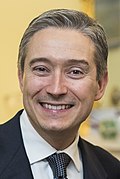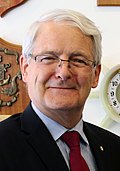Top Qs
Timeline
Chat
Perspective
29th Canadian Ministry
Government cabinet of Canada (2015–2025) From Wikipedia, the free encyclopedia
Remove ads
The Twenty-Ninth Canadian Ministry was the Cabinet, chaired by Prime Minister Justin Trudeau, that began governing Canada shortly before the opening of the 42nd Parliament. The original members were sworn in during a ceremony held at Rideau Hall on November 4, 2015. Those who were not already members of the Privy Council were sworn into it in the same ceremony. At the time of its dissolution, the Cabinet consisted of 35 members including Trudeau, with 17 women and 18 men.[2] When the ministry was first sworn in, with 15 men and 15 women (aside from Trudeau), it became the first gender-balanced cabinet in Canadian history.[3]
Trudeau carried out four major cabinet shuffles: one in 2018, one in 2021, one in 2023, and another in 2024.
On October 26, 2021, one month after the 2021 Canadian federal election that gave the governing Liberal Party a second minority mandate; the ministry underwent a cabinet shuffle, resulting in many promotions, demotions, and removals from cabinet.
Following resignations by major Trudeau cabinet leaders in December 2024, the government entered a political crisis as multiple Liberal party members[4][5][6][7][8] and all opposition parties called for Trudeau's resignation and a new election.[9][10] Trudeau announced his intention to resign as prime minister and party leader in early January 2025, and was succeeded by Mark Carney on March 14, 2025.
Remove ads
List of ministers
Summarize
Perspective
By minister
The list below follows the Canadian order of precedence, which is established by the chronological order of appointment to the King's Privy Council for Canada, with former ministers being listed last in order of appointment to the Privy Council.[11]
By portfolio
Remove ads
Renamed, eliminated, and new ministries
Remove ads
Cabinet shuffles
Summarize
Perspective
2018 shuffle
On 18 July 2018, Prime Minister of Canada Justin Trudeau carried out a significant reshuffle of his ministry. This included the adding of 5 new ministry positions, expanding the previous size of cabinet from 30 to 35. The cabinet remained gender balanced.[14][15]
The appointment of Bill Blair as the new Minister of Border Security and Organized Crime Reduction was praised by Opposition Immigration Critic Michelle Rempel, in response to an increase of illegal crossings of the Canada–United States border.[16] The Deputy Leader of the Opposition Lisa Raitt called the reshuffle a "desperate attempt to hit the reset button before the next election".[14]
The reshuffle was labeled by CBC News as Trudeau's re-election kickoff for the 2019 federal election.[17]
2021 shuffle
On 12 January 2021, Trudeau carried out a shuffle of his ministry.[21][22] It came shortly after Innovation minister Navdeep Bains announced he intended to stand down from the government and not seek re-election at the 2021 Canadian federal election.[23] The shuffle spurred speculation of a snap election.[21][22]
2023 shuffle
After a difficult parliamentary term, Trudeau announced the third major re-shuffle of his ministry and the first re-shuffle since the 2021 election, with the exception of ministers Tassi and Jaczek swapping roles in 2022.[24]
2024 shuffle and crisis
The closing months of 2024 saw a wave of resignations in Trudeau's cabinet. On September 19, 2024, Minister of Transport Pablo Rodriguez resigned to run for leadership of the Quebec Liberal Party.[25] On November 20, 2024, Alberta MP Randy Boissonnault resigned following allegations that he ran a business seeking federal contracts and falsely claimed to be Indigenous.[26] On December 15, 2024, Housing Minister Sean Fraser announced his intention to leave the federal cabinet during the next shuffle, citing personal reasons.[27]
On December 16, 2024, Chrystia Freeland resigned as Deputy Prime Minister and Minister of Finance, hours before she was due to release the government's fall economic statement.[28] She was replaced by Dominic LeBlanc, who would temporarily retain his role as Minister of Intergovernmental Affairs, Infrastructure and Communities.[28] Freeland was often nicknamed the "minister of everything", and widely seen as a potential successor to Trudeau for the leadership of the Liberal Party.[29][30]
In her resignation letter, Freeland reported Trudeau had asked her to resign as finance minister and that she would be offered another Cabinet position. She instead decided to resign altogether from his Cabinet, saying that "to be effective, a Minister must speak on behalf of the Prime Minister and with his full confidence. In making your decision, you made clear that I no longer credibly enjoy that confidence."[31]
Freeland's resignation came amid threats from the incoming Trump administration to impose 25% tariffs upon Canada,[32] as well as Freeland's reported opposition to Trudeau's promise of $250 cheques to working Canadians who earned $150,000 or less in 2023.[33] In her letter, Freeland implicitly referred to this proposal as a "costly political gimmick" and argued that the Canadian government should "[keep] our fiscal powder dry today, so we have the reserves we may need for a coming tariff war."[34]
The resignation raised speculation as to the future of Trudeau's leadership.[32][35] The economic statement was eventually released at 4:11 PM EST that same day, showing a deficit of $61.9 billion for 2023–24, exceeding Freeland's target of $40.1 billion or less, and left Trump's tariff threats largely unaddressed.[36]
Shuffle
After a series of resignations and retirements of ministry members, Trudeau announced his fourth major reshuffle amid a political crisis.[37] Previously in 2024, there were minor changes in the ministry following the resignations of Randy Boissonnault, Chrystia Freeland, Pablo Rodriguez, and Seamus O'Regan. Boissonnault was succeeded by Ginette Petitpas Taylor, Freeland was succeeded by Dominic LeBlanc in the finance portfolio, Rodriguez was succeeded by Anita Anand, and O'Regan was succeeded by Steven MacKinnon. Fraser resigned four days before the reshuffle.
Remove ads
See also
Notes
- Confidence and supply agreement with the New Democratic Party from March 2022 to September 2024[1]
- Title of office was "Minister of Intergovernmental Affairs" until October 26, 2021.
- Title of office was "Minister of Small Business, Export Promotion and International Trade" until October 26, 2021, and then "Minister of International Trade, Export Promotion, Small Business and Economic Development" from October 26, 2021 to July 26, 2023
- Title of office was "Minister of Natural Resources" until July 26, 2023.
- Title of office was "Minister of Innovation, Science and Economic Development" until November 20, 2019.
- Title of office was "Minister of Status of Women" until December 13, 2018.
- Title of office was "Minister of International Development and La Francophonie" until July 18, 2018.
- Title of office was "Minister of Canadian Heritage and Multiculturalism" from July 18, 2018 to November 20, 2019
Remove ads
References
Wikiwand - on
Seamless Wikipedia browsing. On steroids.
Remove ads






































































